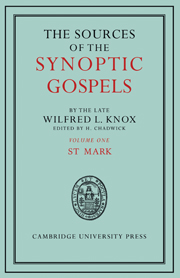Book contents
- Frontmatter
- Dedication
- Contents
- EDITOR'S PREFACE
- PREFACE
- ABBREVIATIONS
- INTRODUCTION
- I The first group of conflict-stories
- II The Twelve-source
- III Jesus and the devils
- IV The book of parables
- V Books of miracles
- VI Nazareth and John the Baptist
- VII Corban and miscellaneous incidents
- VIII A book of localized miracles
- IX The ‘Central Section’
- X The entry to Jerusalem
- XI A second group of conflict-stories?
- XII The warning against the scribes
- XIII The ‘Little Apocalypse’
- XIV The Passion story
- XV The Resurrection story
- SUMMARY
- INDEXES
I - The first group of conflict-stories
Published online by Cambridge University Press: 05 July 2014
- Frontmatter
- Dedication
- Contents
- EDITOR'S PREFACE
- PREFACE
- ABBREVIATIONS
- INTRODUCTION
- I The first group of conflict-stories
- II The Twelve-source
- III Jesus and the devils
- IV The book of parables
- V Books of miracles
- VI Nazareth and John the Baptist
- VII Corban and miscellaneous incidents
- VIII A book of localized miracles
- IX The ‘Central Section’
- X The entry to Jerusalem
- XI A second group of conflict-stories?
- XII The warning against the scribes
- XIII The ‘Little Apocalypse’
- XIV The Passion story
- XV The Resurrection story
- SUMMARY
- INDEXES
Summary
This group of stories (Mark ii. I—iii. 6) has been investigated by Albertz, whose conclusions seem quite convincing. It is, however, worth noting that the group of stories may well have begun not with ii. I, but with i. 40. For the stories as a group would seem intended to meet the question, familiar to anyone who has ever tried to teach the Gospel story to children or simple people: ‘Why if Jesus was the Messiah, did his own people want to kill him?’ And from this point of view the story of the leper would make an admirable beginning, since it proves that Jesus did not begin by breaking the law; on the contrary he observed it. The method is that normal with ancient writers, who prefer to make their point by incidents, rather than by the discussion of tendencies.
But the group of stories throws a peculiar light on the transmission of the tradition. The question in the ancient world would only be raised on the soil of Palestine, or in a predominantly Jewish community. Gentile anti-semitism would ask for no explanation of Jewish hostility to Jesus; it was the sort of thing that might be expected of Jews. Thus Luke finds no difficulty in opening his Gospel with the scene of the rejection at Nazareth, though in his version Jesus appears to reject the Jews before they reject him (Luke iv. 16ff.).
- Type
- Chapter
- Information
- The Sources of the Synoptic Gospels , pp. 8 - 16Publisher: Cambridge University PressPrint publication year: 2011

